1804 Silver Dollar Coin Value: How Much Is It Worth?
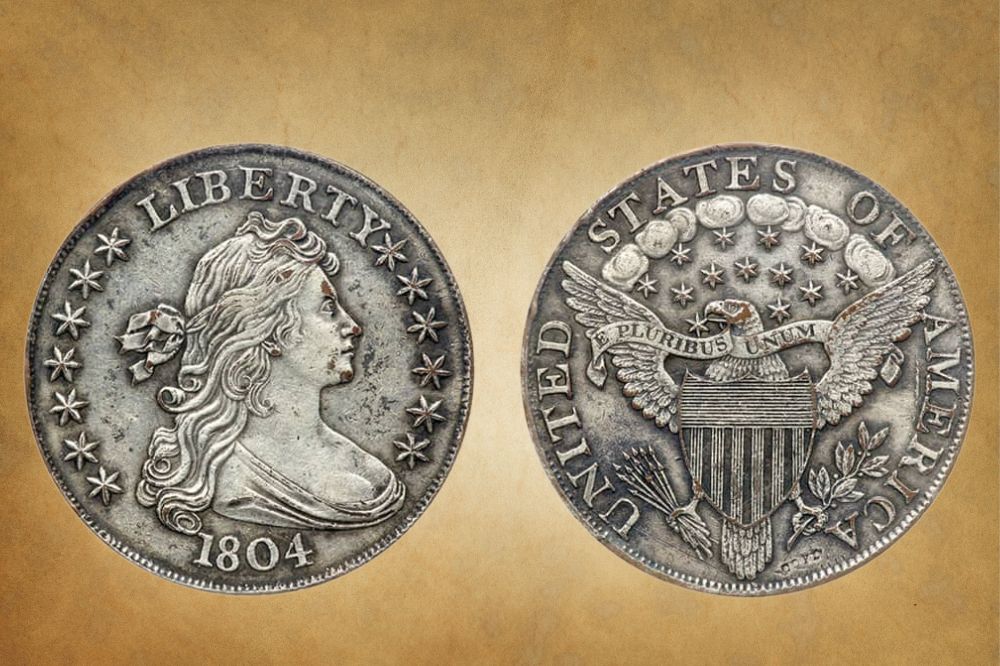
Are you a collector interested in the 1804 silver dollar? Well, there is a reason this unique currency is known as the King of American Coins—it is one of the rarest and most expensive coins the United States Mint has ever produced.
There is a lot of interest in the 1804 dollar, but the truth is this coin is out of the reach of most collectors because of its high price. All in all, this is one coin that would be an excellent addition to your collection if you are lucky to find it.
In this article, you will learn everything you need to know about the 1804 silver dollar, including its interesting history, outstanding features, and the coin’s real value.
Let’s get started.
1804 Silver Dollar Value Chart |
||||
| Mint mark | Good | Fine | Extremely Fine | Uncirculated |
| 1804 Class I Silver Dollar Value | – | – | – | $7,680,000 |
| 1804 Class II Silver Dollar Value | – | – | – | – |
| 1804 Class III Silver Dollar Value | – | – | – | $3,250,000 |
1804 Silver Dollar Value Guide
Let us now take a deep dive and find out how much is an 1804 silver dollar worth. The Mint at Philadelphia produced three varieties of this coin in different years.
The three varieties of the 1804 silver dollar are:
- The 1804 Class I Silver Dollar
- The 1804 Class II Silver Dollar
- The 1804 Class III Silver Dollar
Let’s look at each coin type and discover its value
1804 Class I Silver Dollar Value
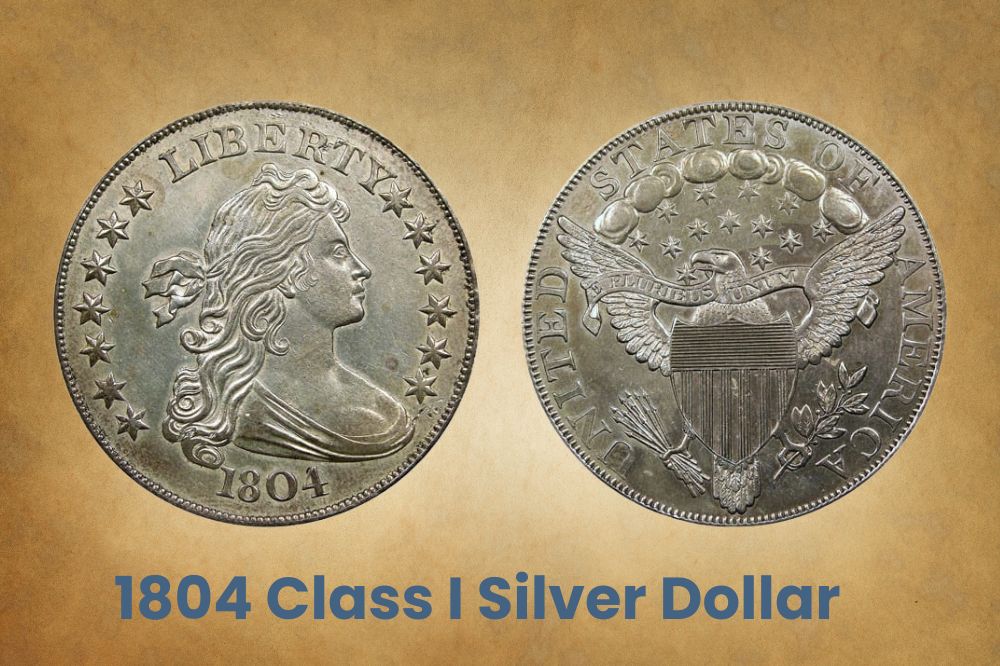
The Class I 1804 silver dollar is believed to have been struck at the Philadelphia mint between 1834 and 1835. This coin is also known as the Siam or the Muscat specimen, as it was first gifted to government officials in the two countries.
Given that these coins were not meant for circulation and were struck as proof coins, the Mint produced and distributed only eight examples.
The eight existing examples are:
- The U.S. Mint Specimen
- Mickley Specimen
- Dexter Specimen
- Stickney Specimen
- Parmelee Specimen
- King of Siam Specimen
- Watters-Childs Specimen
These specimens range from proof (PR) grade 55 to 68 and are worth between $2,500,000 and $7,680,00. Specifically, the Sultan of Muscat-Watters-Brand-Childs-Pogue sold for a whopping $7,680,000 at the Stack’s Bowers Galleries in 2021.
The Watters-Child Specimen of the 1804 silver dollar was the single finest example in the Class I proof set and was graded PR68 by the Professional Coin Grading Service.
1804 Class II Silver Dollar Value
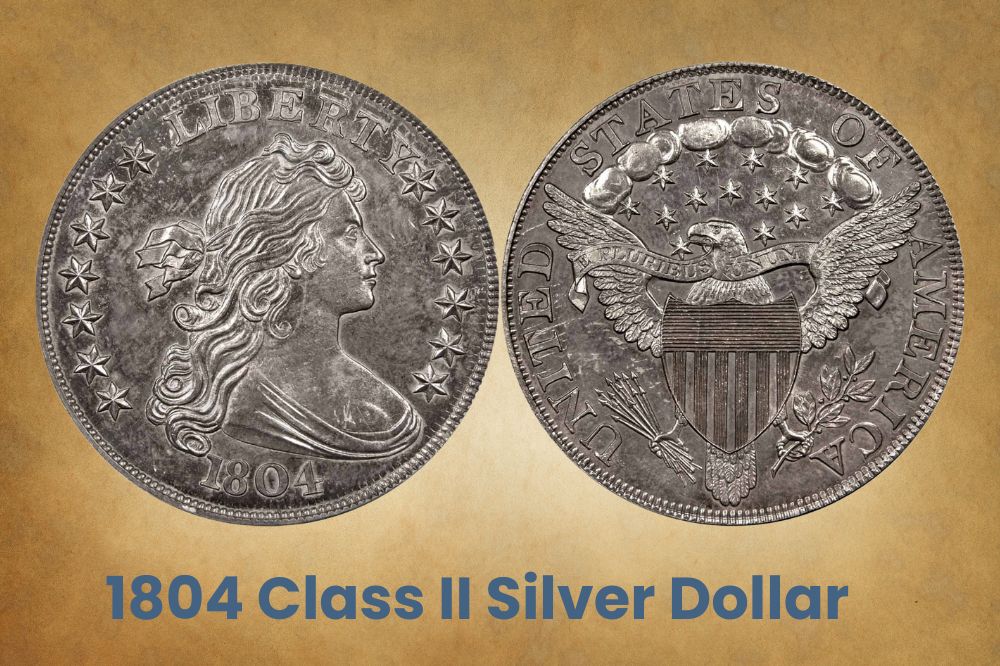
In 1857 or thereabout, mint workers illegally re-struck the original 1804 dollars, but this second set of proof coins had a plain edge, lacking the lettering on the original Class I 1804 silvers.
It is unclear how many clandestine coins mint worker Theodore Eckfeldt struck. But, the Mint tracked and destroyed the coins lacking edge lettering once it discovered the illegal production.
Today, there is only one example of the Class II 1804 silver dollar. This plain edge coin was struck over an 1857 Swiss Bern Shooting Thaler and is currently in possession of the U.S. Mint at the Smithsonian.
The value of the 1804 Class II silver dollar is unknown.
1804 Class III Silver Dollar Value
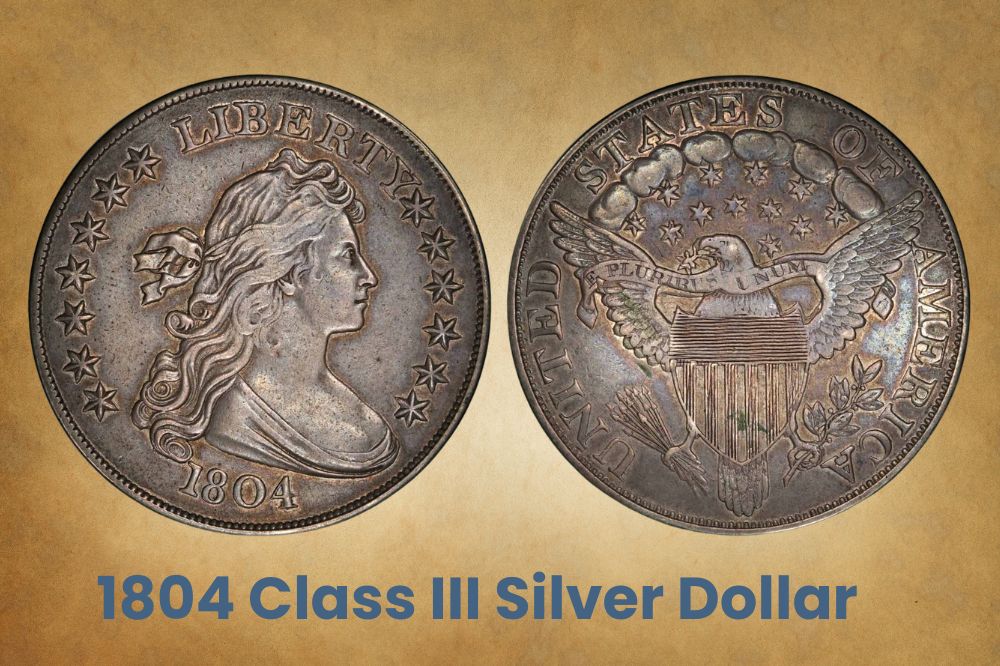
The Class III silver dollar was also a re-strike made by Theodor Eckfeldt. It bears a resemblance to the Class II dollar. The only difference between the two re-strikes is that the Class III silver dollar has a lettered edge like the Class I coin.
The other noticeable difference is that the Class III silver dollar has a slightly bowed appearance. It is believed that the mint workers etched the edge lettering after striking the coins, yet the Castaing machine for edge lettering is meant for use before striking. The improper use of the machine resulted in the coin’s concave appearance.
Only six examples of the Class III 1804 silver dollars were struck. These specimens are:
- The Rosenthal
- The Berg
- The Davis
- The Linderman (Belongs to DuPoint and is now housed at the American Numismatic Association
- The Adama
- The Idler
These coins are worth between $1,800,000 and $3,250,000, ranging from grade PR40 to PR68.
Related Posts: 11 Most Valuable One Dollar Coin Worth Money
1804 Silver Dollar Error Coins
Today, there are only fifteen known examples of the 1804 silver dollar. This number includes Class I, Class II. and Class III silver dollars.
Although Class II and Class III coins were minted illegally, all these were minted as proofs and were not meant for general circulation.
No known 1804 silver dollar error coins are separate from or included in the fifteen coins minted since 1834.
Related Posts: 16 Most Valuable Presidential Dollar Coins Worth Money
History of the 1804 Silver Dollar
Also known as the Draped Bust Liberty Dollar and nicknamed the King of American Coins, the 1804 silver dollar was not minted in 1804; production of this limited edition coin began in 1834.
Edmund Roberts, a commercial shipper and a United States government envoy to Asia, proposed to the United States Mint to produce proof coins to gift his hosts. Roberts first gifted the coins to his hosts in Muscat and Siam and had planned to do the same for government officials in Cochichina and Japan, but he died in Macau before the second set of the special silver dollars was delivered.
In addition to the silver dollars struck to be used as diplomatic gifts, the Mint also struck some that it gave collectors in exchange for pieces it needed for its own collection. Collectors found out about the 1804 silver dollar in 1842 when a drawing of the coin appeared in a popular numismatic publication by Mint workers.
In 1843, a collector acquired the draped bust silver dollar from the Mint. Subsequently, mint employees secretly, without government approval, produced several examples of the 1804 dollar in 1858. But, these coins did not have the correct lettering around the edges.
Collectors rejected this second re-strikes due to the lack of edge lettering. The Mint destroyed all but one in response to the rejection and the fact that these coins were clandestinely produced. The remaining Class II 1804 silver dollar is preserved at the Smithsonian National Numismatic Collection.
A third set of the Draped Bust dollar was struck in small quantities, but this time, the coins featured the correct edge lettering as the official diplomatic coins. Only six examples of this third set of dollars are known to exist today.
The three sets of coins which include the diplomatic set, and the second and third strike sets, are known as Class 1, Class II, and Class III dollars.
Related Posts: 12 Most Valuable Susan B. Anthony Coin Worth Money
How to Identify the 1804 Silver Dollar?
The 1804 silver dollar is among the most beautiful United States currencies. Let’s look at the features of the famous Draped Bust dollar.
Because these coins were not meant for circulation, any you will find will be in pretty good shape, and your 1804 silver dollar is very likely worth thousands of dollars.
The Obverse of the 1804 Silver Dollar
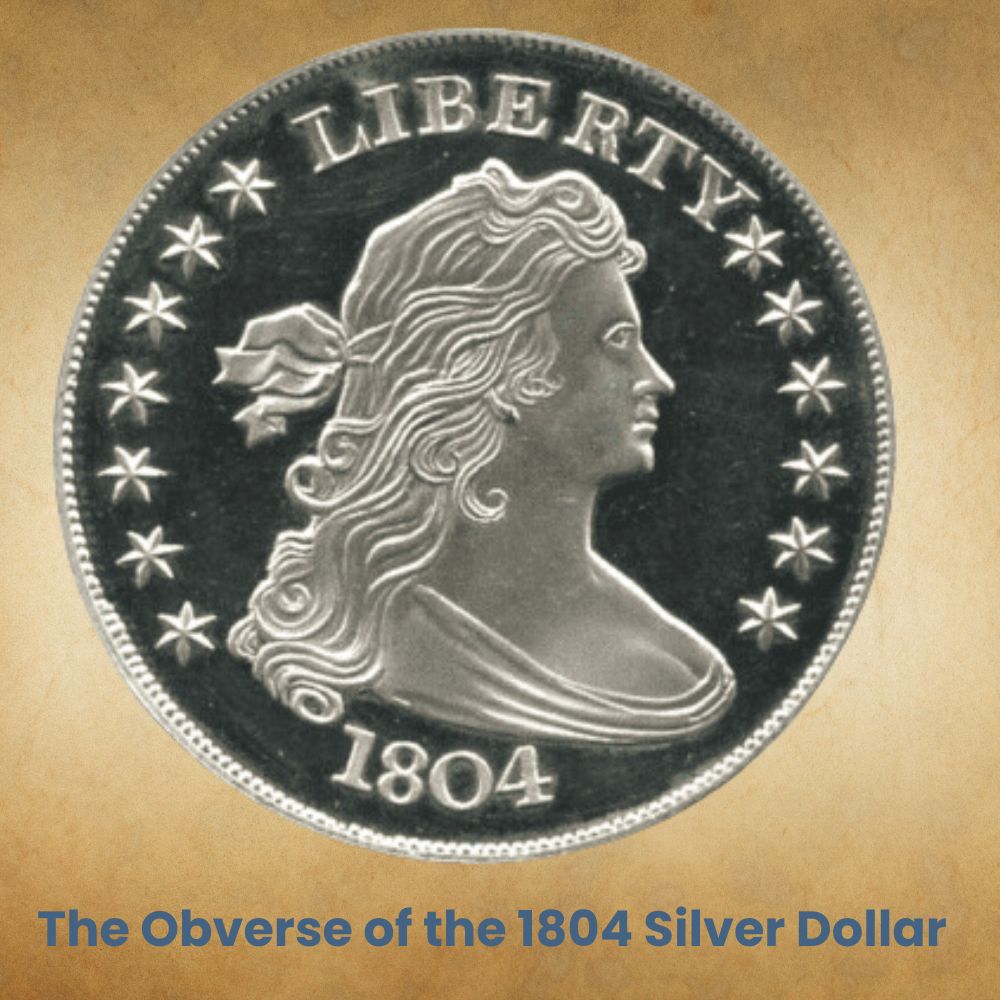
The obverse or head of the 1804 silver dollar features a right-facing Draped Bust portrait of Lady Liberty. A few strands of her flowing hair are pinched in a flowy ribbon.
The word LIBERTY is inscribed around the coin’s top edge while the date, 1804, appears around the bottom edge.
There are thirteen stars on the obverse, seven appearing on the left and six on the right. Denticles dot the coin’s circumference.
The Reverse of the 1804 Silver Dollar
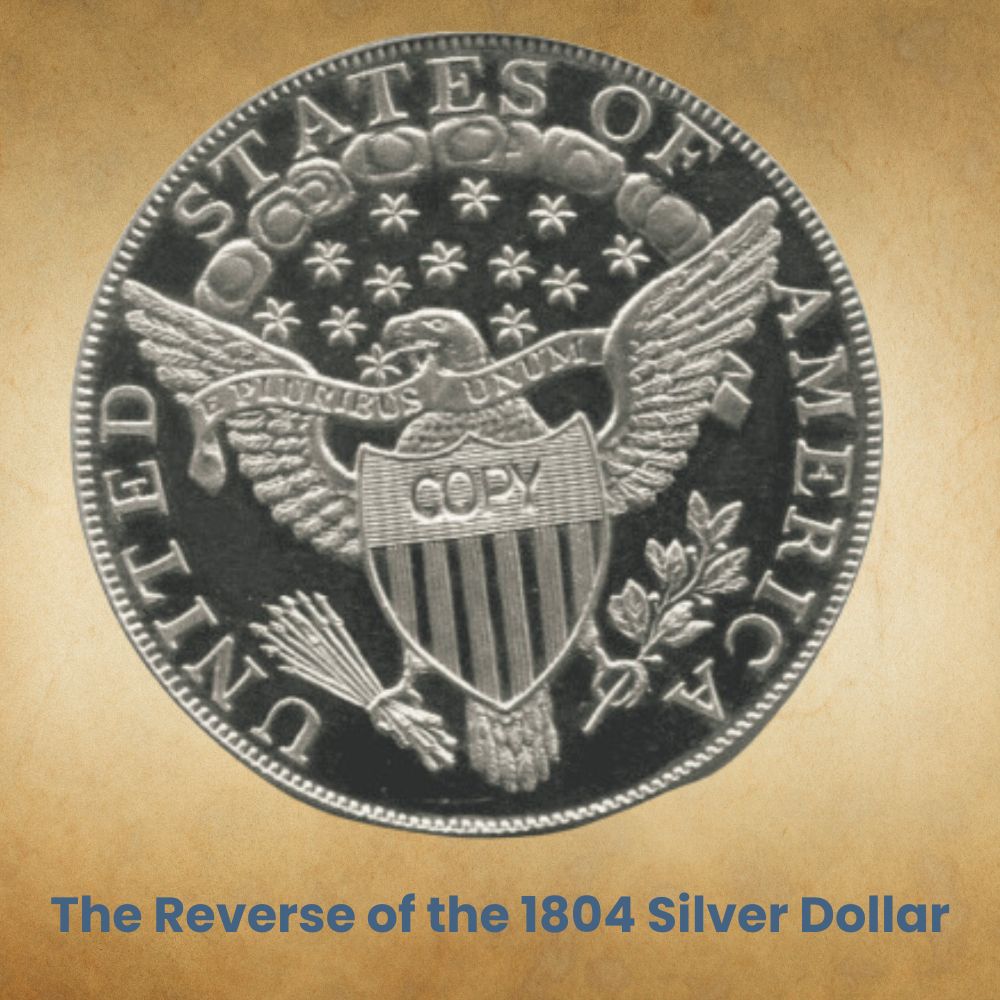
The reverse depicts a heraldic eagle with its wings spread out. In its left talon, the eagle holds an olive branch and a set of arrows on its right.
A banner with the motto E PLURIBUS UNUM is draped around the eagle’s neck. A shield is etched in front of the eagle, covering the bird’s chest entirely.
Above the eagle’s head are what look like clouds, and thirteen stars sprinkled out overhead.
The words UNITED STATES OF AMERICA occupy the entire reverse circumference. Unlike Class II and Class III 1804 silver dollars, the space between the words STATES and OF is smaller in the Class I coin.
This coin was likely struck in 1834 or 1835 due to its distinct raised ledge and denticles along the coin’s circumference, a common design in coins minted in the 1830s.
Other Features of the 1804 Silver Dollar
The 1804 silver dollar is composed of 90% silver and 10% copper.
The coin weighs 27 grams and measures 40mm in diameter. It had no mintmark as it was struck as a proof coin at the Philadelphia mint.
The edge of the 1804 silver dollar is lettered with the words HUNDRED CENTS ONE DOLLAR OR UNIT
Related Posts: 18 Most Valuable Morgan Silver Dollar Worth Money
FAQS
Undoubtedly, there is a lot of numismatic interest around the 1804 silver dollars. Here are common questions collectors have about The King of American Coins:
Is an 1804 silver dollar rare?
1804 silver dollars are among the rarest in U.S. history. Even though it is believed that close to 20,000 were minted since 1834, only 15 known specimens exist today. These exclusive coins are extremely expensive, ranging from $1 million to $7 million. The truth is, most collectors cannot access the fifteen specimens as they are pricey, and many are in the possession of the U.S. Mint.
How can you tell if an 1804 silver dollar is real?
First things first, 1804 silver dollars are extremely expensive and out of the reach of most common collectors. If someone tries selling you a cheap issue, it is likely a fake 1804 silver dollar. All fifteen known examples have provenance or a known origin. If the origin or history of the coin you are looking at is sketchy, it is probably a counterfeit. Lastly, all 1804 silver dollars were proof coins, so the strike is of visibly higher quality, and the fields are shiny. So if a coin is worn out and is claimed to be an 1804 dollar, there is likely no truth in such a claim.
Are all 1804 silver dollars accounted for?
The story of the 1804 Draped Bust dollar is draped in mystery, especially when the illegally minted Class II and Class III coins are concerned. It is a generally accepted truth that the Mint recovered all but one of the illegal Draped Bust dollars. Overall, it is believed that only 15 examples of these coins are accounted for and exist worldwide.
